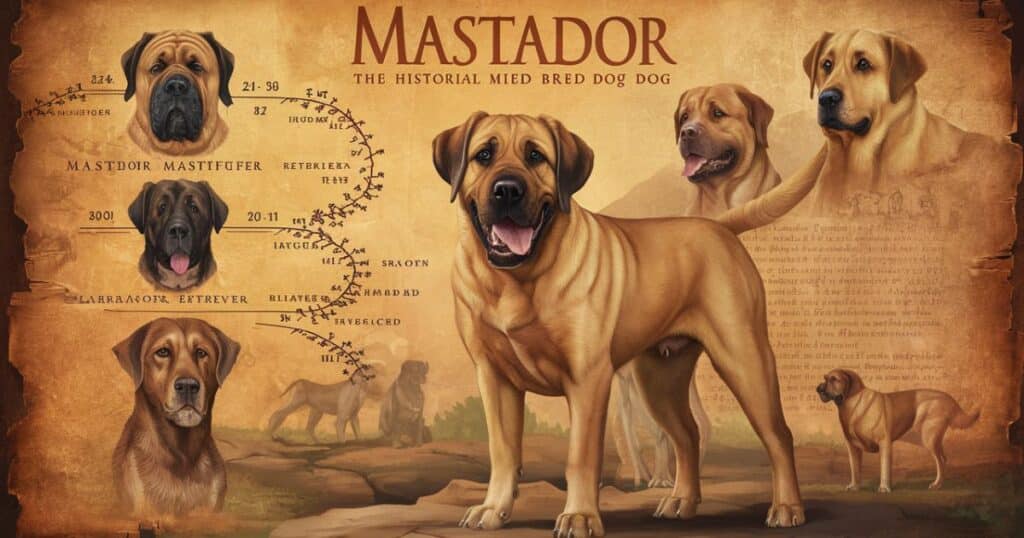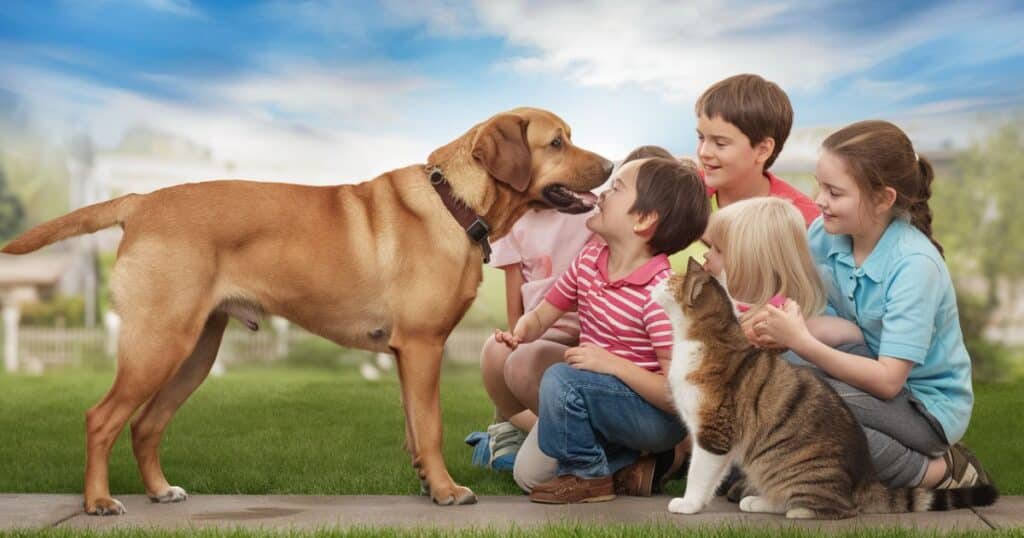Are you captivated by the idea of a gentle giant? A loyal, affectionate canine companion with an imposing stature yet a heart of gold? Look no further than the Mastiff Labrador Mix, fondly known as the Mastador. This hybrid cross between the majestic English Mastiff and the friendly Labrador Retriever has taken the dog world by storm, capturing hearts with its unique blend of size, strength, and unwavering devotion.
In this comprehensive guide, we’ll delve into the fascinating world of the Mastador, exploring its rich history, distinctive traits, and the joys and responsibilities of owning one of these gentle giants. Get ready to fall in love with this crossbreed designer dog as we unravel the secrets behind their endearing personalities and unmatched companionship.
So, What Is A Mastador?
The Mastador is a cross between two renowned pedigree breeds: the English Mastiff and the Labrador Retriever. This hybrid inherits the best qualities from both parent breeds, resulting in a loyal, intelligent, and affectionate family pet. While not recognized as an official breed by major kennel clubs, the Mastador has gained immense popularity among dog enthusiasts seeking a gentle giant with a loving nature.
History of the Mastador Breed

To truly appreciate the Mastador, we must first explore the rich histories of its parent breeds.
History of the English Mastiff
The English Mastiff, one of the oldest breeds in the world, traces its roots back to ancient times. Originally bred for guarding and protection, these massive working dogs were highly valued by noblemen and warriors alike. Their imposing size, strength, and unwavering loyalty made them formidable guardians, yet their gentle nature with their families earned them the affectionate moniker “the Gentle Giants.”
History of the Labrador
On the other hand, the Labrador Retriever has its origins in the rugged landscapes of Newfoundland, Canada. Originally bred as a sporting dog to aid fishermen in retrieving nets and ropes from icy waters, the Lab’s intelligence, trainability, and friendly disposition quickly made them beloved family companions. Their loyalty, eagerness to please, and boundless energy have solidified their status as one of the most popular breeds worldwide.
The Mastador’s heritage perfectly blends the Mastiff’s stoic guardianship with the Labrador’s outgoing affection, creating a truly unique and captivating companion.
ALSO READ: 38 Amazing Labrador Retriever Mixes You Need To Know About
Mastador Temperament and Personality Traits
Common Personality Traits
One of the most endearing aspects of the Mastador is its gentle, loving nature. Despite their imposing size, these crossbreeds are known for their patience, affection, and unwavering loyalty towards their pet parents. Mastadors thrive on human companionship and form incredibly strong bonds with their families, making them exceptional household pets.
While their Mastiff lineage instills a natural guarding instinct, proper socialization and training can channel this protective nature into a well-mannered, trustworthy companion. Mastadors are generally good with children and other pets when introduced and supervised appropriately.
What are the main characteristics of a Mastador?
Loyalty and companionship
Loyalty is a hallmark trait of the Mastador, inherited from both parent breeds. These devoted companions form unbreakable bonds with their families and thrive on human interaction. They crave quality time and affection, making them ideal household pets and constant companions.
Reputation
The Mastador has quickly gained a reputation as a gentle, loving, and devoted family pet. Their loyalty, patience, and affectionate nature have endeared them to dog enthusiasts worldwide, contributing to their growing popularity as a designer dog.
Popularity
While still a relatively new hybrid, the Mastador’s popularity has skyrocketed in recent years. Their unique blend of size, strength, and gentle temperament has captured the hearts of many, making them a sought-after choice for families seeking a loyal, affectionate companion.
Trainability
Inheriting the intelligence and eagerness to please from their Labrador lineage, Mastadors are generally highly trainable. With positive reinforcement and consistency, they can excel in obedience training, making them well-mannered companions in various settings.
Power and intelligence
The Mastador’s impressive size and strength are balanced by their intelligence, inherited from both parent breeds. Their quick learning abilities and eagerness to please make them highly responsive to training, ensuring they can be well-mannered family pets.
Socialization
Early and proper socialization is crucial for Mastadors, especially considering their size and protective instincts. Exposing them to various sights, sounds, and experiences from a young age helps shape well-rounded, confident, and friendly companions.
Purpose
While not bred for a specific working purpose, the Mastador excels as a loyal companion dog and household pet. Their gentle nature, affection, and protective instincts make them ideal family dogs, providing a sense of security and unwavering companionship.
Behavior
Mastadors are generally calm and gentle indoors but require regular exercise and mental stimulation to prevent boredom and destructive behaviors. With proper training and socialization, they can be well-behaved, loving additions to any household.
Physical Characteristics of a Mastador
What Does the Mastiff Labrador Mix Look Like?
The Mastador’s appearance is a striking blend of its parent breeds. They inherit the Mastiff’s large, muscular frame and the Labrador’s sleek, athletic build. Their size can vary depending on which parent they take after more, but they are typically large to giant dogs.
Mastadors often have broad heads, floppy ears, and a muscular, sturdy build. Their expressions can range from gentle and friendly to alert and imposing, reflecting their unique blend of traits.
How Big Does A Mastador Get?
Given their impressive size, it’s no surprise that Mastadors are considered giant breed dogs. Here are some typical size ranges:
- Height: 24 to 30 inches (61 to 76 cm)
- Weight: 120 to 230 pounds (54 to 104 kg)
Male Mastadors tend to be larger than females, but individual sizes can vary significantly based on their specific genetic makeup and environmental factors.
Coat and Colors
Mastadors can inherit a wide range of coat types and colors from their parent breeds. Their coats can range from short and smooth to longer and slightly coarse, with varying degrees of shedding.
Common color variations include:
- Black
- Chocolate
- Yellow
- Fawn
- Brindle
Their coats may also feature unique markings or patterns, adding to their distinctive appearance.
Health and Lifespan of a Mastador

Common Health Issues
Like all breeds, Mastadors are predisposed to certain health conditions, some of which are inherited from their parent breeds. Responsible breeders and pet parents should be aware of these potential issues to provide proper care and preventive measures.
Some common health concerns for Mastadors include:
- Hip and elbow dysplasia
- Bloat (gastric dilatation-volvulus)
- Eye conditions (cherry eye, entropion, ectropion)
- Ear infections
- Heart issues
- Obesity (due to their large size and potential overeating)
Regular veterinary checkups, appropriate exercise, and a balanced diet can help mitigate the risk of developing these conditions.
How Long Does the Mastador Live?
The average lifespan of a Mastador ranges from 8 to 12 years. However, with proper care, a high-quality diet, and regular veterinary attention, some Mastadors have been known to live longer, up to 14 years or more.
Health problems and health issues
While generally healthy, Mastadors can be prone to certain health issues, especially if not provided with proper care and preventive measures. Responsible pet parents should be proactive in addressing potential health concerns to ensure their furry companions live long, happy lives.
Regular exercise, a balanced diet, and routine veterinary check-ups can help prevent or manage conditions like:
- Obesity: Due to their large size and potential for overeating, Mastadors require portion control and appropriate exercise to maintain a healthy weight.
- Joint issues: Hip and elbow dysplasia can be inherited from either parent breed, so monitoring their activity levels and providing joint supplements may be beneficial.
- Bloat: This life-threatening condition, also known as gastric dilatation-volvulus, is a risk for large and giant breed dogs like Mastadors. Feeding them multiple smaller meals throughout the day and avoiding excessive exercise after eating can help reduce the risk.
- Eye conditions: Cherry eye, entropion, and ectropion are potential eye issues that Mastadors may inherit from their parent breeds. Regular eye checks and prompt treatment are essential.
- Ear infections: Due to their floppy ears, Mastadors can be prone to ear infections, especially if their ears aren’t kept clean and dry. Routine ear checks and cleaning can prevent chronic issues.
- Heart issues: Some inherited heart conditions, like dilated cardiomyopathy, can affect Mastadors. Regular veterinary checkups and screenings can help detect and manage these issues early on.
By being proactive about their health needs, responsible pet parents can help ensure their Mastadors live long, happy, and healthy lives.
Caring for a Mastador
Dietary Needs
Proper nutrition is crucial for the overall health and well-being of these large crossbreed dogs. Mastadors have significant dietary requirements due to their size and energy levels.
Here are some key points to consider:
- High-quality, age-appropriate dog food formulated for large or giant breeds is essential to support their growth and development.
- Puppies require a diet rich in proteins, fats, and calories to fuel their rapid growth.
- Adult Mastadors may benefit from a lower-calorie diet to maintain a healthy weight and prevent obesity.
- Seniors may require a diet tailored to their changing nutritional needs and lower activity levels.
- Always consult with a veterinarian or pet nutritionist to determine the appropriate portion sizes and dietary requirements for your Mastador.
Exercise Requirements
As a high-energy breed, Mastadors require regular exercise to maintain their physical and mental well-being. Their activity needs may vary based on their age and individual personality, but here are some general guidelines:
- Daily walks or jogs, ideally for an hour or more, are recommended to meet their exercise needs.
- Playtime in a securely fenced yard or dog park can provide additional opportunities for running and burning off energy.
- Mental stimulation through obedience training, puzzle toys, and interactive games can help prevent boredom and destructive behaviors.
It’s essential to start exercise routines slowly and gradually increase the intensity, especially for puppies and seniors, to avoid joint stress and injury.
Importance of Low-Impact Activities For Mastiff Lab Mixes
Due to their substantial size and weight, high-impact activities like running on hard surfaces or excessive jumping can put significant strain on a Mastador’s joints. To promote joint health and longevity, it’s crucial to incorporate low-impact exercises into their routine.
Suggested Low-Impact Exercises
- Swimming: This full-body, low-impact exercise is excellent for building muscle strength and cardiovascular endurance without putting excessive stress on the joints.
- Walking or hiking: Leisurely walks or hikes on softer surfaces like trails or beaches can provide ample exercise while minimizing joint impact.
- Nose work or scent games: Engaging their natural scenting abilities through games and activities can provide mental stimulation and moderate physical activity.
- Gentle stretching and massage: Regularly stretching and massaging your Mastador’s muscles can improve flexibility and circulation, promoting overall well-being.
Grooming Tips
Mastadors have moderate grooming needs, with their coat type and shedding levels varying based on which parent breed they take after more.
Here are some grooming tips to keep your furry friend looking and feeling their best:
- Brushing: Regular brushing, at least once a week, can help remove loose hair and prevent excessive shedding. Invest in a quality slicker brush or deshedding tool.
- Bathing: Mastadors only need occasional baths, typically every 8-12 weeks or as needed. Use a gentle, dog-safe shampoo and conditioner to maintain their coat’s health.
- Nail trimming: Their nails should be trimmed regularly, every 4-6 weeks, to prevent overgrowth and potential discomfort or injury.
- Ear cleaning: Due to their floppy ears, regular ear checks and gentle cleaning can help prevent ear infections and wax buildup.
- Dental care: Brushing their teeth regularly or providing dental chews can help maintain good oral hygiene and prevent dental issues.
Establishing a consistent grooming routine from an early age can help your Mastador become accustomed to the process and make it a positive experience for both of you.
Training a Mastador
How should you train a Mastiff Labrador Retriever mix?
Training a Mastador requires patience, consistency, and a positive approach. Their size and strength can make traditional dominance-based training methods ineffective and potentially dangerous. Instead, focus on positive reinforcement techniques that leverage their eagerness to please and intelligence.
- Start early: Begin socialization and basic obedience training as early as possible, ideally during puppyhood. This helps establish a strong foundation for good behavior and manners.
- Use positive reinforcement: Reward-based training methods, such as using treats, praise, and playtime as rewards, are highly effective for Mastadors.
- Be consistent: Consistent rules, commands, and consequences are crucial for successful training. Ensure all family members are on the same page to avoid confusing the dog.
- Break it down: Due to their size, Mastadors may benefit from breaking down complex commands into smaller, more manageable steps.
- Provide mental stimulation: Challenge their intelligence with puzzle toys, nose work games, and obedience training to prevent boredom and destructive behaviors.
- Be patient and gentle: Mastadors respond best to calm, patient guidance. Avoid harsh corrections or punishment, which can damage their trust and willingness to learn.
- Consider professional training: For more challenging behavior issues or specialized training needs, seeking the guidance of a professional dog trainer can be invaluable.
With proper training and socialization, Mastadors can grow into well-mannered, obedient companions that bring joy and security to their families.
Mastador as a Family Pet: Suitability with Kids & Other Animals

Mastadors can make excellent family pets when properly socialized and trained from an early age. Their gentle, affectionate nature and patience make them well-suited for households with children.
However, it’s essential to consider a few factors:
- Supervision: Due to their substantial size, Mastadors should always be supervised around small children to prevent accidental injuries or knocking them over.
- Proper introduction: Introduce your Mastador to children gradually and teach them how to interact respectfully with the dog, avoiding rough play or pulling on ears or tails.
- Training: Invest in obedience training to ensure your Mastador understands basic commands and responds reliably to your instructions.
- Socialization: Socialize your Mastador from an early age with children, other animals, and various environments to promote confidence and good behavior.
With the right preparation and guidance, Mastadors can make loving, loyal, and protective companions for families with children. As with any dog, it’s crucial to teach children how to interact safely and respectfully with their furry friends.
When it comes to other animals, Mastadors can coexist peacefully with proper introductions and supervision. Their natural protective instincts may make them wary of unfamiliar animals initially, but with positive reinforcement and socialization, they can learn to accept and even befriend other pets in the household.
ALSO READ: The Joy Of Labrador Retriever Puppies: A Complete Guide
Adopting a Mastador
Finding a Breeder
If you’ve decided that a Mastador is the right breed for you, the next step is finding a reputable breeder. Here are some tips to help you locate a responsible Mastador breeder:
- Research breeders thoroughly, checking reviews, references, and their knowledge of the breed.
- Look for breeders who prioritize health testing for both parent breeds and can provide documentation.
- Avoid breeders who seem more focused on making a profit than on the well-being of the dogs.
- Be prepared to get on a waiting list, as responsible breeders often have limited litters.
- Ask about the breeder’s socialization and early training practices for the puppies.
- Visit the breeder’s facility to ensure the dogs are kept in clean, humane conditions.
Reputable breeders will be happy to answer your questions, provide health certifications, and guide you through the adoption process.
Adoption Process
The adoption process for a Mastador puppy can vary depending on the breeder, but here’s a general overview:
- Application and Interview: Breeders will typically have you fill out an application and may conduct an interview to ensure you are prepared for the commitment of owning a Mastador.
- Wait List: Due to the growing popularity of Mastadors and responsible breeders having limited litters, you may be placed on a wait list. Be prepared for this process to take time.
- Deposits and Contracts: Once a litter becomes available, the breeder will likely require a deposit to reserve your puppy. You’ll also need to review and sign a contract outlining the terms of the adoption.
- Puppy Selection: Some breeders allow new owners to select their puppy, while others match puppies based on personality fit. Be open and trust the breeder’s guidance.
- Pickup and Supplies: When your puppy is ready (usually 8-12 weeks old), you’ll go to the breeder to pick them up, along with supplies like food samples, medical records, and care instructions.
- Follow-Up Support: Reputable breeders will provide ongoing support and resources to help you acclimate your new Mastador puppy to their forever home.
The adoption process ensures you receive a healthy, well-socialized puppy while the breeder finds committed owners for their litters.
Meet some of the Mastadors!
To give you a better sense of what these lovable giants are like, let’s meet some real-life Mastadors and their owners:
Ruby (owner Megan)
Ruby is a 3-year-old female Mastador who lives in Oregon with her owner Megan. At 175 pounds, Ruby is an imposing presence, but her gentle nature and love for cuddles belie her size. Megan shares, “Ruby is the biggest sweetheart. She adores children and is so patient and loving with them, despite her size.”
Mousse (owner Mike)
Mousse, a 2-year-old male Mastador from California, has stolen the hearts of Mike’s whole family. “He’s an absolute goofball,” Mike says with a laugh. “Mousse loves to play and always keeps us entertained with his silly antics. But he’s also incredibly loyal and protective when needed.”
Friendly Juno
Juno, a 4-year-old female Mastador from Texas, is a local celebrity in her neighborhood for her friendly, outgoing personality. Her owner, Jessica, shares, “Juno greets everyone with a wagging tail and lots of slobbery kisses. She’s the ultimate ambassador for the breed.”
Rocko (owner Christopher)
At 200 pounds, Rocko is an impressive sight, but his owner Christopher raves about his gentle demeanor. “Rocko is a true gentle giant. He’s incredibly patient with my kids and has never shown any aggression, even when they accidentally step on his tail or pull his ears.”
Bruce (owner Gillian)
Bruce, a 5-year-old male Mastador from New York, is a service dog specializing in mobility assistance. His owner, Gillian, praises his intelligence and eagerness to work. “Bruce is an absolute lifesaver. He’s highly trained but also has an amazing intuition for anticipating my needs.”
Gabriel, Bleu and Journey
This trio of Mastadors from Florida, aged 2 to 4 years old, are a tight-knit pack. Their owners, the Smith family, share how these gentle giants have brought so much joy and laughter into their home. “They each have their own unique personalities, but they’re all equally loving and devoted to our family.”
Bubba
Bubba, a 7-year-old male Mastador from Colorado, is a true gentle giant according to his owner, Sarah. “Despite his massive size, Bubba is the sweetest, most affectionate dog I’ve ever known. He adores children and is incredibly gentle with them.”
Alvin
At 4 years old, Alvin from Ohio is a beloved therapy dog who brings comfort and joy to nursing home residents. His owner, Mark, shares how Alvin’s calm demeanor and loving nature make him the perfect companion for those in need of emotional support.
Ozzy
Ozzy, a 3-year-old male Mastador from California, is a true adventure buddy according to his owner, Jake. “Ozzy loves hiking and camping with me. He has endless energy on the trails but is also the biggest cuddle bug when we’re relaxing by the campfire.”
Hector and Douglas
These two Mastador brothers, aged 5 and 6, from Massachusetts are inseparable best friends. Their owners, the Wilson family, share how these gentle giants have brought so much love and laughter into their lives. “Hector and Douglas are truly part of our family. We can’t imagine our home without their goofy antics and unconditional love.”
These real-life Mastadors and their owners showcase the breed’s incredible diversity in personality and temperament, while highlighting their unwavering loyalty and affectionate natures.
Mastiff mixed with Lab Puppies For Sale

If you’ve fallen in love with the Mastador breed after learning about them, you may be wondering where to find Mastiff Lab mix puppies for sale. While not as readily available as some purebred dogs, there are a few options to explore:
- Reputable Breeders: As mentioned earlier, locating an ethical, responsible Mastador breeder should be your top priority. Be prepared to get on a waitlist and go through an extensive screening process.
- Breed-Specific Rescues: Some breed-specific rescues may occasionally have Mastador puppies or young adults available for adoption after being surrendered by previous owners.
- Online Listings: Websites like PuppyFind and NextDayPets sometimes list Mastiff Labrador mix litters from various breeders. Thoroughly vet any breeders before considering a purchase.
- Local Shelters: While less common, it’s always worth checking your local animal shelters and rescue organizations, as mixed breed puppies may sometimes become available.
No matter where you obtain your Mastador puppy, be prepared for the substantial commitment of time, resources, and unwavering care that these large breed dogs require throughout their lives.
Meet the Parents: The parents’ breed history
To fully understand the Mastador, it’s essential to explore the rich histories and characteristics of its parent breeds: the English Mastiff and the Labrador Retriever.
Parent 1: History of the Mastiff – purebred dogs
The Mastiff is one of the oldest and most prestigious breeds in the world, with origins dating back thousands of years. These massive, muscular dogs were highly prized by ancient civilizations for their strength, courage, and unwavering loyalty.
These two different Mastiffs are similar but with a few noticeable differences
- English Mastiff: Originally bred in England for guarding estates, hunting, and bloodsports, the English Mastiff is known for its gentle nature, despite its imposing size and strength.
- Spanish Mastiff: Also known as the Mastin Español, this ancient breed was used for guarding livestock and property in Spain. They are known for their independent nature and have a more athletic build compared to the English Mastiff.
Both Mastiff breeds share a rich history as formidable guardians and loyal companions, contributing their impressive size, strength, and devoted temperaments to the Mastador.
Parent 2: History of the Labrador Retriever, a purebred dog
The Labrador Retriever, on the other hand, has a more recent history dating back to the 19th century in Newfoundland, Canada. Originally bred as a water dog to assist fishermen in retrieving nets and ropes from icy waters, the Lab quickly gained popularity for its intelligence, trainability, and friendly disposition.
As their reputation spread, Labradors were introduced to England and eventually became one of the most beloved family companions and sporting dogs worldwide. Their outgoing personalities, eagerness to please, and boundless energy have made them a favorite among dog lovers of all ages.
By combining the Mastiff’s stoic guardianship with the Labrador’s outgoing affection, the Mastador inherits a truly unique blend of characteristics from its esteemed parent breeds.
Meet the offspring: The Mastiff Lab mix
The Mastador is the result of carefully combining the best traits of these two iconic breeds, creating a loyal, loving, and gentle companion dog. While inheriting the Mastiff’s impressive size and strength, the Mastador also gains the Labrador’s intelligence, trainability, and friendly nature.
This hybrid breed offers a unique combination of qualities that make them excellent family pets, watchdogs, and loyal companions. With proper socialization and training, Mastadors can be well-mann
Mastiff Lab Mix Facts
Now that you’ve learned about the histories and traits of the parent breeds, let’s explore some interesting facts about the Mastiff Lab mix itself.
3 Reasons Why You Shouldn’t Get a Lab Mastiff Mixed-breed
While Mastadors make wonderful companions for the right families, they’re not a suitable breed for everyone. Here are three key reasons why a Mastiff Lab mix may not be the best choice:
- Size and Space Requirements: As a giant breed, Mastadors require a significant amount of living space, both indoors and outdoors. They’re not well-suited for apartment living or homes without access to a securely fenced yard.
- Exercise and Activity Needs: These high-energy dogs require a substantial amount of daily exercise and mental stimulation to prevent boredom and destructive behaviors. Families with relatively sedentary lifestyles may struggle to meet their activity requirements.
- Potential for Accidental Injury: Despite their gentle natures, Mastadors’ sheer size and strength can pose a risk of accidentally knocking over small children or elderly individuals. Proper training and supervision are crucial.
Best Dog Food for Mastiff Lab Mix

Providing a high-quality, balanced diet is essential for the health and well-being of your Mastador. Due to their large size and high energy levels, they have specific nutritional needs that must be met.
When choosing dog food for your Mastiff Lab mix, look for:
- Large or Giant Breed Formulas: These recipes are designed to meet the unique nutritional requirements of larger dogs, including appropriate levels of proteins, fats, and calories.
- High-Quality Protein Sources: Lean meats, fish, and eggs provide the essential amino acids needed for muscle development and maintenance.
- Omega Fatty Acids: These healthy fats promote skin and coat health while also supporting joint mobility.
- Glucosamine and Chondroitin: These supplements can help support joint health and mobility, which is crucial for giant breeds prone to conditions like hip and elbow dysplasia.
- Appropriate Calorie Content: Mastadors are prone to obesity, so choosing a food with the right calorie density for their age, activity level, and size is crucial.
Additionally, consider consulting with a veterinarian or pet nutritionist to develop a customized feeding plan that meets your Mastador’s specific dietary needs throughout their various life stages.
3 Reasons Why You Should Get a Mastiff Lab Mixed-breed
While Mastadors may not be the right fit for everyone, they offer a unique combination of traits that make them excellent companions for the right owners. Here are three compelling reasons to consider adding a Mastiff Lab mix to your family:
- Loyal and Affectionate Companions: Mastadors are known for their unwavering loyalty and affectionate nature, forming strong bonds with their families and thriving on human companionship.
- Versatile and Intelligent: With their impressive size, strength, and intelligence inherited from both parent breeds, Mastadors can excel in various roles, from family companions to service dogs and even therapy work.
- Gentle Giants: Despite their imposing stature, Mastadors are renowned for their gentle, patient demeanor, making them excellent family pets when properly socialized and trained.
An Important Note
Regardless of whether you decide to welcome a Mastador into your home, it’s crucial to do thorough research, seek guidance from experienced owners and professionals, and ensure you’re prepared for the significant commitment of time, resources, and care that these giant breed dogs require throughout their lives.
Final Thoughts
The Mastiff Labrador Mix, or Mastador, is a truly remarkable breed that combines the best qualities of two iconic dog lines. With their impressive size, gentle nature, and unwavering loyalty, these gentle giants have captured the hearts of dog lovers worldwide.
While owning a Mastador comes with unique challenges and responsibilities, the rewards of their companionship are immeasurable. From their goofy antics and boundless affection to their protective instincts and trainability, Mastadors have proven themselves to be exceptional family pets.
As with any breed, proper research, preparation, and commitment are essential to providing a Mastador with the care, exercise, and socialization they need to thrive. But for those willing to invest the time and effort, these lovable crossbreeds will undoubtedly repay you with a lifetime of unconditional love, loyalty, and countless cherished memories.
So, if you’re ready to welcome a gentle giant into your life, the Mastador may just be the perfect companion you’ve been searching for. Embrace their unique blend of strength, intelligence, and affection, and prepare to fall head over heels for these remarkable canine companions.
ALSO READ THIS POST: Gorgeous Silver Labrador Retriever Puppies For Sale
FAQ’s
Are Mastiff Lab mixes good dogs?
Yes, Mastiff Lab mixes (Mastadors) generally make excellent dogs for the right owners. They are loyal, gentle, and affectionate companions. With proper training and socialization, they can be well-mannered family pets.
Is a mastador a good dog?
Absolutely, mastadors can make wonderful dogs for active families or individuals. Their friendly temperament, eagerness to please, and protective nature make them great companions. However, their size and exercise needs require a committed owner.
What is the temperament of a Bullmastiff Lab mix?
The temperament of a Bullmastiff Lab mix is typically gentle, loyal, and protective. They inherit the Bullmastiff’s guarding instincts balanced by the Labrador’s friendly nature. Proper socialization is crucial to shape their confidence and behavior.
How big is a mastador?
Mastadors are considered giant breed dogs. They can range from 24-30 inches tall and weigh anywhere between 120-230 pounds when fully grown. Males tend to be larger than females, but size can vary based on genetics.

Davin Connor is an experienced author with 3 years in pets writing. Known for concise, informative content, he shares expertise on pet care, behavior, and health through his engaging articles.






